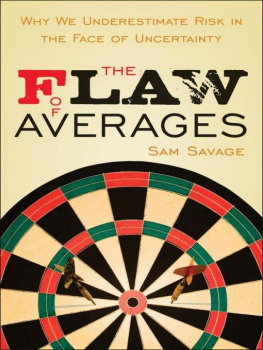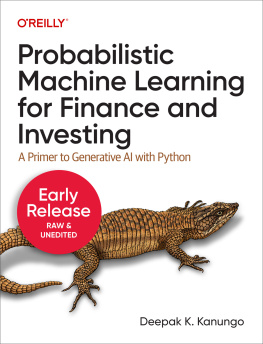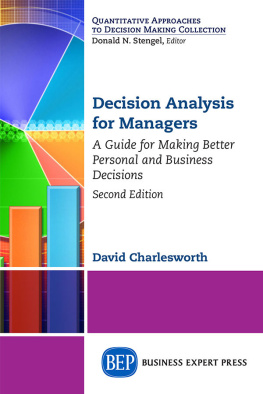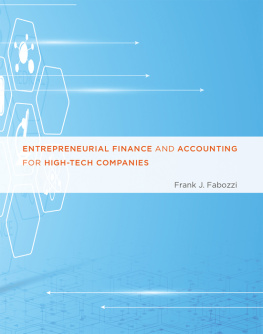Table of Contents
Copyright 2009 by Sam L. Savage. All rights reserved.
Published by John Wiley & Sons, Inc., Hoboken, New Jersey.
Published simultaneously in Canada.
No part of this publication may be reproduced, stored in a retrieval system, or transmitted in any form or by any means, electronic, mechanical, photocopying, recording, scanning, or otherwise, except as permitted under Section 107 or 108 of the 1976 United States Copyright Act, without either the prior written permission of the Publisher, or authorization through payment of the appropriate per-copy fee to the Copyright Clearance Center, Inc., 222 Rosewood Drive, Danvers, MA 01923, (978) 750-8400, fax (978) 646-8600, or on the web at www.copyright.com. Requests to the Publisher for permission should be addressed to the Permissions Department, John Wiley & Sons, Inc., 111 River Street, Hoboken, NJ 07030, (201) 748-6011, fax (201) 748-6008, or online at http://www.wiley.com/go/permissions.
Limit of Liability/Disclaimer of Warranty: While the publisher and author have used their best efforts in preparing this book, they make no representations or warranties with respect to the accuracy or completeness of the contents of this book and specifically disclaim any implied warranties of merchantability or fitness for a particular purpose. No warranty may be created or extended by sales representatives or written sales materials. The advice and strategies contained herein may not be suitable for your situation. You should consult with a professional where appropriate. Neither the publisher nor author shall be liable for any loss of profit or any other commercial damages, including but not limited to special, incidental, consequential, or other damages.
For general information on our other products and services or for technical support, please contact our Customer Care Department within the United States at (800) 762-2974, outside the United States at (317) 572-3993 or fax (317) 572-4002.
Wiley also publishes its books in a variety of electronic formats. Some content that appears in print may not be available in electronic books. For more information about Wiley products, visit our web site at www.wiley.com.
Library of Congress Cataloging-in-Publication Data:
Savage, Sam L., 1944-
The flaw of averages : why we underestimate risk in the face of uncertainty / Sam L. Savage.
p. cm.
Includes bibliographical references and index.
eISBN : 978-0-470-48856-0
1. Risk. 2. Uncertainty. I. Title.
HB615.S313 2009
338.5dc22
2008052144
For Daryl, Jacob, and Russell, and in
memory of Fruipit, our beloved dog
Preface
T he Flaw of Averages describes a set of common avoidable mistakes in assessing risk in the face of uncertainty. It helps explain why conventional methods of gauging the future are so wrong so often , and is an accessory to the recent economic catastrophe. Once grasped, these ideas can lead recent us to more effective forecasting and decision making. Traditionally, these topics have been the domain of probability and statistics. Although I will assume no prior knowledge of these subjects, for those who have had formal training in these subjects, it should take only a few chapters to repair the damage.
My perspective no doubt derives largely from my father, Leonard Jimmie Savage. Although well below average on academic scales during his early education, he emerged as a prominent mathematical statistician who collaborated closely with Milton Friedman, among others. One of their students was the founder of modern portfolio theory, Harry Markowitz, who claims that my father indoctrinated him at point blank range with rational expectation theory. Thus I am a child of the University of Chicago School of Economics.
Early on it was clear I possessed at least one of my fathers traits. I, too, was a below-average student, displaying neither athletic nor academic aptitude. The defining moment of my high school education came in an after-class conference with my English teacher in my junior year at the University of Chicago Laboratory School. She explained that I was failing the course, but with a monumental effort might achieve a D by the second semester. Then she helpfully explained the underlying problem: The Lab School was for students who would go on to college, which, quite clearly, I would not. Instead she suggested a technical school where I could get practical training as a mechanic or a plumber.
She therefore presented me with my first serious career decision: to work my butt off for a lousy D in English or play my guitar for immediate gratification. I made the obvious choice, and music has brought me joy and solace ever since. Better yet, I was able to have my cake and eat it too, because I ended up with a D anyway. In retrospect I cannot question this individual teachers judgment, because all told I received three Ds in four years of high school English, each under a different instructor.
My father was in no position to complain, because when he graduated from high school in Detroit, he too was classified by his teachers as not college material, and consequently was refused admission to the University of Michigan.
Once again I followed in my fathers footsteps, later flunking out of the University of Michigan myself, although based on academics rather than involuntary arson.
As adolescent misfits, then, neither of us was able to conform to the norms expected by our teachers. Thus nonaverageness itself became a family value, perhaps in some way inspiring this book. After being de-Michiganized, however, our careers diverged. My father fought his way back into Michigan, got his PhD in mathematics, and achieved great academic acclaim. I worked as a mechanic and briefly raced a sports car before ultimately getting a degree in computer science, which is, in deference to my English teacher, just plumbing with bits of information instead of water.
Although The Flaw of Averages will discuss concepts from both statistics and economics, I have little formal training in either of these subjectsjust the basics picked up at an early age at the dinner table. Therefore, I have written not from the perspective of a statistician or an economist, but from the perspective of a former mechanic and current plumber of information who grew up surrounded by statisticians and economists.
I came up with some of the core ideas and title for this book in 1999, and I started writing. I knew the concept had potential, but somehow the book was not uplifting: The Flaw of Averages asserts that everything is below projection, behind schedule, and beyond budget. Where was the happy ending?
In search of one, I continued to teach, consult, and write articles about various aspects of this problem. Feeling the need to stake out the real estate (in case I ever did finish the book), I wrote an article in October 2000 on the Flaw of Averages for the San Jose Mercury News. When it was published, it was, to my surprise, adorned with a drawing by the renowned cartoonist Jeff Danziger depicting a statistician drowning in a river that is on average three feet deep. This is reproduced in Chapter 1 of this book.
Over the years, I have had the good fortune to interact with some exceptional people in academia and industry who were grappling with the Flaw of Averages themselves. As a result of this interaction, an approach that we call Probability Management has recently emerged, offering a potential cure for many variants of this problem. And so at last with a happy ending in hand, I renewed my writing efforts in earnest in 2006. All told, on average , I have written 21 words per day since 1999.












